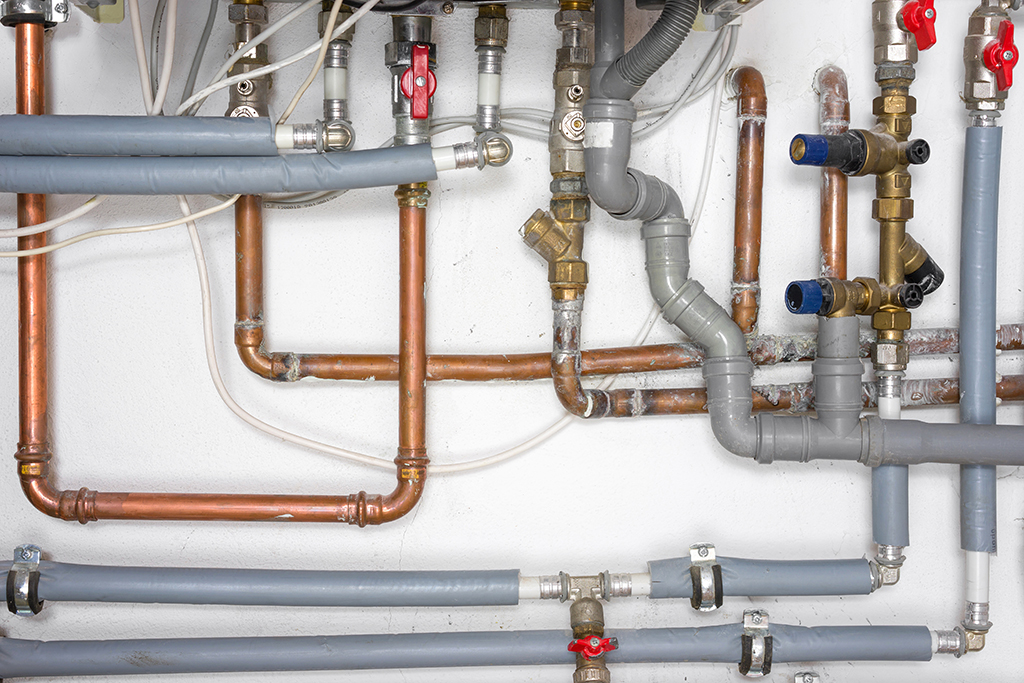Knowing what types of pipes are in your home will allow you to make a better decision compared to others who are unaware of the differences or advantages between plumbing types. When you call for plumbing service they may ask what type of materials you have in your house so they can be ready with the right tools and equipment to fix your problem. Las Vegas, NV has a variety of houses and a variety of materials used inside of them for your plumbing. We’ll go over the more popular materials as well as mentioning what their advantages and disadvantages are.
The Metals
The first, and least likely you’ll see for your water supply of our list is cast iron. Cast iron may still be used for drain pipes for your sewers but it is rare that you’ll see cast iron for your base water lines because of its propensity to rust, and your plumbing service won’t likely use it. On the plus side cast iron is very strong and durable, making it quieter and is great at absorbing temperature fluctuations. Cast Iron can be replaced in sections with plastic piping but you don’t want to patch it too much.
Another type of iron pipes, black iron, are even less likely to be used for plumbing in today’s homes. It was quite popular in the past but now is used primarily for natural gas or propane lines as well as sprinkler systems because it is good at resisting heat in those applications.
Stainless steel is still used today although it’s not very popular because of its price except in areas where corrosion is an issue like near the ocean. Stainless steel pipes are very sturdy and are available in both flexible and rigid styles.
We’ll give a short mention here to lead based pipes that may still be in your Las Vegas, NV home although it may not be very common in our area. Lead lined galvanized steel pipes should be replaced when disturbed or discovered as it only takes one instance of change in water supply levels to cause leaching into your water supply. While you can still get zinc lined galvanized steel older galvanized pipes have a high likelihood of corroding as they have short lifespans. Plumbing services will also tell you that galvanized pipes are extremely heavy and vulnerable to damage both inside and outside. In fact many people with galvanized pipes who call for low water pressure find out it’s their feed lines from the municipal water service that is constricting their supply.
The most common type of metal pipe you’ll see come from a professional plumber for your house’s jobs is copper. Copper is a very traditional plumbing material as it is a safe, long lasting, and tolerant metal. Copper pipes should last at least 50 years before needing replacement. It is durable meaning that it is unlikely to leak or corrode. Copper is also naturally antibacterial, making it safer for you and your family and it does not pollute the water that is running through it. Copper is extremely popular for hot water runs because copper has very high temperature tolerances compared to non-metals and you won’t lose a lot of heat as it runs through your home. When it is time to replace copper it can be recycled to recoup some costs of your new project. On the downside copper can be extremely expensive per square foot and the cost of mining new copper for pipes, which at this time can’t be made from recycled copper, is extremely high on the environment.
Non-Metal Pipes
For the non-metal pipes you may see used in your house by plumbing services we’ll start with the one people recognize the most, PVC, which stands for polyvinyl chloride. This material is a thermoplastic polymer that is a mix of plastic and vinyl. PVC is great for highly pressured water lines and can last indefinitely if cared for. PVC is also extremely light making it easy to work with and connect. PVC is also cheap compared to other products, driving its popularity up and costs down. However PVC should not be used for hot water as it it can melt the pipe, and the space required for PVC connectors could be more than narrow walls may allow.
A chemical cousin of PVC is CPVC, which is chlorinated polyvinyl chloride. CPVC is used by plumbing services to handle hot water as it is almost identical to PVC in pros and con except for that one major pro. This does increase the cost slightly over standard PVC but not a lot. CPVC does have another disadvantage that many grades of PVC do not and that is UV breakdown. CPVC should not be exposed to sunlight as that will break down the material over time and your plumbing service will be aware of this.
A third and final non-metal option for plumbing is cross linked polyethylene pipes, called PEX by plumbing services. PEX is one of the most recent home plumbing inventions on the market and is the most flexible piping material in many ways. PEX can be used for any plumbing application as it can be used in long continuous runs without connectors or cuts being required to turn corners. There are versions that are rated for hot and cold water as well as waste lines. PEX pipes can last forever if it isn’t tampered with. PEX is also super flexible, allowing it to be shoved through walls to get to your hookups. This flexibility means it is easy to use as well. Some types of PEX have had issues with taste and odor immediately after installation but its biggest downside is that it can also be damaged when exposed to UV rays.
Now that you know what plumbing services use for your house you should get a hold of one for yourself. Craig’s Plumbing offers a full suite of plumbing services and offers a lifetime plumbing warranty.



